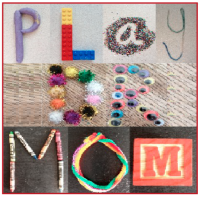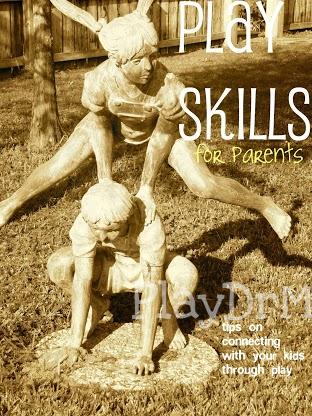Play Skills for Parents
When teaching a class on play therapy, I teach and quiz my students on basic skills of being a child-centered play therapist. I also discuss using these same skills with the parents of my children clients to help decrease problematic behaviors and increase the parent-child relationship. At times this is part of using Filial (parent/child) Play Therapy with a family … in which a train parents/caregivers to use play therapy with their own children to address the therapeutic presenting issues. Other times I just suggest a couple of the skills for parents to incorporate into their daily routines.
So, here I share these play skills for parents with you … hopefully to improve your play experience with your children. Let me know how it goes!
1. Structuring Skill – what to say when starting and ending each special play session; how to help your child/client understand how the play sessions work and to set the tone.
Introductory Message: “[Child’s name], this is a very special playroom. You can do almost anything you want to do in this room. If there is something you may not do, I will let you know.”(VanFleet, 2000, p. 21). OR …. “ [Child’s name], this is our playroom, and this is a place where you can play with the toys in a lot of the ways you’d like to.” (Giordano, Landreth, & Jones, 2005, p. 26)
Playroom Departure: Time warnings are given prior to the ending of the session. Five minutes prior to the end of session, you say, “[Child’s name], we have five more minutes in the playroom today.” At the end of the session, pleasantly and firmly say, “[Child’s name], our time is up for today. We need to leave the playroom now.” (VanFleet, 2000, p. 21).
2. Empathic Listening Skill – There are MANY elements to this basic skill. The first is to show the child/client that he or she has your complete attention and that you will accept him or her. It is a way for you to “walk in the child’s shoes.” You will be showing acceptance by reflecting feelings and “giving a play-by-play” commentary of the actions in session. In doing so, you will assist “the child in developing a greater self-awareness by making specific responses … Through increasing personal awareness of feelings, the child has a greater understanding of his emotional state. Also, responses that acknowledge the child’s competencies help the child gain a clearer understanding of personal strengths and abilities” (Giordano, Landreth, & Jones, 2005, p. 30).
1. Before the session (and periodically throughout, if your mind wanders!) practice epoche (clearing your mind) in order to keep your attention on the child.
2. Use your own words to describe the actions of the session and paraphrase any statements made by the child/client. Focus especially on any feelings.
3. Avoid asking questions or telling the child what to do – this is the child’s session to lead (hence, child-centered play therapy!). Remember, most questions can easily be turned into statements.
4. Redirect questions that the child/client asks, such as “what is this for?” by reflecting the question (“You’re trying to figure out what that is?”. If the child persists, say, “In our special playroom it has been many different things. You can use it just about anyway you’d like.” If the child STILL persists, give a simple answer, such as “Some people might use it as a …, but you can use it just about any way you’d like.”
5. If the child/client says, “Don’t repeat me!” or “Why are you talking like that?” Make sure you are varying your restatements, explain that you are trying to understanding everything this he or she is saying, and (if all else fails) reduce or eliminate reflective statements for awhile. (VanFleet, 2000, pp. 23-24).
3. Imaginary Play Skill – This skill is essential for the times when the child/client want you to play with them. At this point, you “drop” the reflective statements and join in the play until the session switches out of imaginary play. It could be he or she asking you to take on a role (like the superhero or “bad guy”) or it could be a tea party, puppet show, playing house, school, or store. During this time the child will be the director of the play – and you follow their lead. If you aren’t sure what the child wants you to do, try something and watch for the child’s reaction. (Most times they will make sure you are on the right track!) If you are totally at a lost of what to do, ask in a whisper, “What would you like me to do?”
4. Limit Setting Skill – This skill keeps you and the child safe during the sessions . With effective limit setting by the therapist, children learn that they are responsible for what happens to them if they make a choice or break a limit after they have been previously warned and informed of the consequences. The number of limits is kept to a minimum in order to foster an atmosphere which permits freer expression. In setting limits, consider whether the limit is necessary for the child’s safety, your safety, or the protection of valuable toys or property. (see Limit Setting post)
Laura Hutchison
Latest posts by Laura Hutchison (see all)
- Hacked By GeNErAL - August 21, 2015
- ABCs of Easy Crafts for Kids - August 14, 2015
- What is Learned through PLAY - August 12, 2015
- ABCs of Playground Parkbench - August 7, 2015
- ABCs of Encourage Play - July 31, 2015


















Happy to know you! Love to learn and know these books and ways of moving.
Thanks for sharing!
Angelique
These are great tips to improve play time with your child. You can download some cute wall art reminding parents or any adults the rules for play time. Check it out here http://www.growingplay.com/freeparentplay.html
Such great information – thank you! Lots to think about…